|
"Although many
caches have been reported, there must have been an unknown number
discovered by farmers and laborers of which no record was ever kept."---------1910,
by Warren K. Moorehead, "Cached Flint Objects," The Stone Age In
North America, pp. 217-218.
"In
conclusion, spatial analysis of the Sloan-site artifacts indicates that
at least twenty-nine discrete artifact clusters (caches)
are present. This implies the existence of approximately thirty
individual graves within the cemetery."---------1997,
by Dan F. Morse, "Sloan, A Paleoindian Dalton Cemetery in Arkansas, p.
92.
"Large Dalton
points were the most common burial offering (found
on the Sloan site) in 18 of the 29
defined clusters (caches)."---------2006,
by Robert E. Funk and Bradley T. Lepper, p.187.

DALTON CACHE
SCOTT COUNTY, MISSOURI
The Dalton cache illustrated here is reported to have been found in the
Spring of 2007 by a farmer, Wilford Gean. It was found in a cultivated
field in Scott County, Illinois approximately three miles west of the Olive Branch site.
|
|
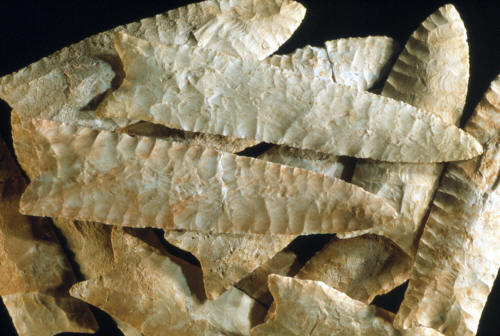
CLICK ON PICTURE FOR LARGER IMAGE
DALTON CACHE
SCOTT COUNTY, MISSOURI
PRIVATE COLLECTION
This cache contains thirteen Dalton points. A fourteenth point is
reported to have been broken and discarded. All of the points were
made of Burlington chert. They range in size
from 6 1/2 inches (16.5cm) for the longest to 4 3/8 inches (11.1cm) for the smallest. |
|
|
Caches of Dalton points have been reported from northeastern Arkansas,
southeastern Missouri and southern Illinois. This area seems to have
produced the majority of all Dalton artifact caches. Twenty-nine caches
were reported from the Sloan Dalton cemetery site in northeastern
Arkansas. Those caches included all types of Dalton points and tools,
such as scrapers, abraders, adzes, bifaces and utilized flakes. |
|
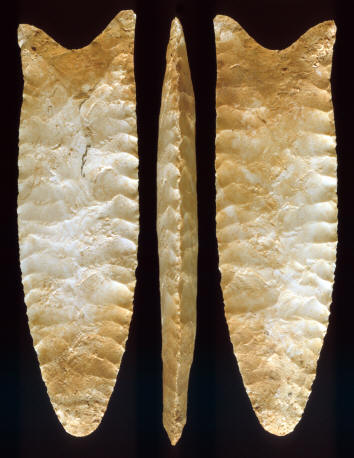
CLICK ON
PICTURE FOR LARGE TRIPLE IMAGE
DALTON CACHE
SCOTT COUNTY, MISSOURI
PRIVATE COLLECTION
This Dalton point exhibits fairly uniform parallel pressure flaking
that was so typical of these Early Archaic flintknappers. This point
is made of Burlington chert and measures 4 3/4 inches (12.1cm) long. |
|
|
The "Gean Dalton cache" illustrated here is reported to have once
contained 14 Dalton points. The fourteenth point was evidently lost or
discarded after it was dropped and broken. The average number of
artifacts found in the caches at the Sloan site was eight. The number of
artifacts found in the caches numbered between one and 38 artifacts. |
|
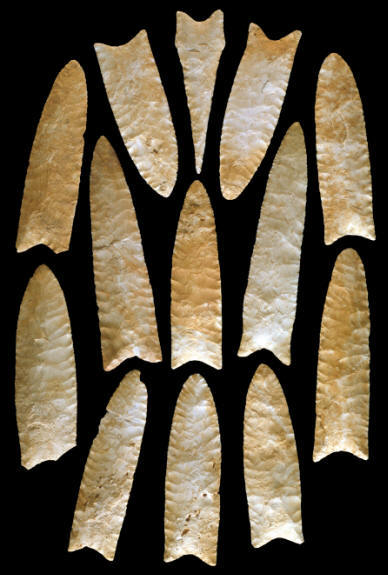
CLICK ON PICTURE FOR LARGER IMAGE
DALTON CACHE
SCOTT COUNTY, MISSOURI
PRIVATE COLLECTION
This picture shows all the Dalton points that were reported to have
been found by a farmer, Wilford Gean.
He found it in the Spring of 2007 in a cultivated field in Scott
County, Missouri. All of the points are made of Burlington chert.
They range in size from 6 1/2 inches (16.5cm) for the longest to 4 3/8 inches (11.1cm) for the smallest. |
|
|
Dalton caches are believed to be artifacts that were once associated
with burials. However, the bones have not survived except for small
fragments reported from the Sloan site. The artifacts on the Sloan site
were often times laid out in a linear fashion which suggested they were
interred with extended burials. |
|
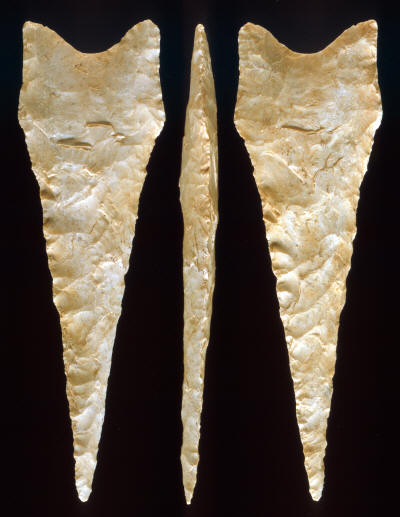
CLICK ON
PICTURE FOR LARGE TRIPLE IMAGE
DALTON POINT
SCOTT COUNTY, MISSOURI
PRIVATE COLLECTION
This is the only extensively resharpened Dalton point found in the "Gean
Dalton cache." These points have often been referred to as drills
but they rarely show any wear pattern that would result from
drilling or punching holes through leather, wood or any other type
of material. This Dalton point is made of Burlington chert and
measures 4 3/8 inches (11.1cm) long. |
|
|
All the Dalton points in this cache are made of Burlington chert.
The quality of the material, except for the two largest examples, is
fairly grainy and porous. They range in size from 6 1/2 inches (16.5cm)
for the longest to 4 3/8 inches (11.1cm) for the smallest. |
|
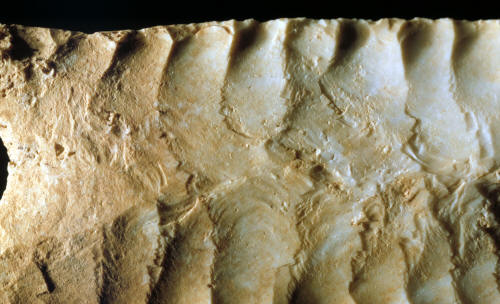
CLICK ON PICTURE FOR LARGER IMAGE
DALTON POINT FLAKING
SCOTT COUNTY, MISSOURI
PRIVATE COLLECTION
This picture shows a magnified view of a portion of an edge of one
of the Dalton points from the "Gean Dalton cache." The long, narrow
pressure flakes represent one of the signature flaking patterns used
by Early Archaic Dalton flintknappers. |
|
|
Dalton caches represent a conceptual tradition that extends far back in
time. Whether it's flowers for the Neanderthal burials at Shanidar or
the golden treasures in King Tut's tomb, the theme is the same, which is
offering good things to the one who has died. Wouldn't it be interesting
to know how far back in time the first human reported seeing the first
ghost. |
|
"REFERENCES"
1910, Moorehead, Warren K., "Cached
Flint Objects," The Stone Age In North America, pp. 217-218.
1912, Hodge, Frederick Webb, "Cache Disks and Blades,"
Handbook of American Indians North of Mexico, part 1, pp.178-179.
1997, Morse, Dan F., "Sloan, A Paleo-Indian Dalton Cemetery in
Arkansas, p. 92.
2006, Funk, Robert E., Lepper, Bradley T., "Paleo-Indian: East,"
Environment, Origins, and Population, Vol. 3, p.187.
2007, Personal communications with David Menze
|
|
RECENT
LISTINGS HOME
ORDERING |